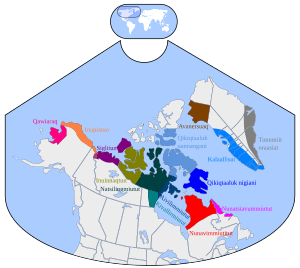Inuttitut facts for kids
Quick facts for kids Inuttitut |
|
|---|---|
| Labrador Inuktitut | |
| Native to | Canada |
| Native speakers | (unknown) |
| Language family | |

Inuit dialects. Nunatsiavummiut is the pink ( ) in the east.
|
|

|
|
Inuttitut, also called Inuttut or Nunatsiavummiutitut, is a special way of speaking Inuktitut. It is used by the Inuit people in northern Labrador, a part of Canada. Their traditional lands are known as Nunatsiavut.
This language has its own unique way of writing. It was created in the 1760s by German missionaries from the Moravian Church who came from Greenland. Because of this different writing system, and because Nunatsiavut is far away from other Inuit communities, Inuttitut has become its own distinct dialect with its own stories and books.
Inuttitut shares some features with other Inuit dialects spoken in Quebec. For example, it simplifies certain consonant sounds. However, Inuttitut is different because it tends to change some sounds like 'g' and 'k' when they are at the end of a word or before another consonant. Also, the way words are built and how sentences are put together can be different. Even within Labrador, there are small differences in how Inuttitut is spoken in places like Rigolet, Nain, and Hebron.
Even though over 4,000 people in Nunatsiavut are of Inuit descent, only about 550 said that an Inuit language was their first language in 2001. Most of these speakers live in the town of Nain. This means that Inuttitut is in serious danger of disappearing.
Contents
The Inuttitut Alphabet
Nunatsiavut uses a Latin alphabet for writing Inuttitut. This alphabet was created by German-speaking missionaries from the Moravian Church. It includes a special letter called ĸ (which is pronounced like 'kra' and can also be written as a capital K).
In 1980, a new writing system was created. This was done at a meeting with elders and teachers to make sure everyone wrote the language in a clear and consistent way. Before this, the letter 'o' was used to represent a 'u' sound before certain other sounds. However, in Labrador Inuttitut, that specific 'q' sound at the end of syllables is no longer used. In the new writing system, the letter 'o' now represents a long 'uu' sound.
| Capital letters | ||||||||||||||||||||
|---|---|---|---|---|---|---|---|---|---|---|---|---|---|---|---|---|---|---|---|---|
| Â | A | E | F | G | H | I | J | K | Kʼ | L | M | N | O | P | R | S | T | U | V | W |
| Lowercase letters | ||||||||||||||||||||
| â | a | e | f | g | h | i | j | k | ĸ | l | m | n | o | p | r | s | t | u | v | w |
Here are the main differences between the Latin alphabet used for Inuttitut and the one used for other Inuktitut dialects:
- The long 'a' sound (â) is written as 'aa' in other dialects.
- The long 'i' sound (e) is written as 'ii' in other dialects.
- The long 'u' sound (o) is written as 'uu' in other dialects.
- The 'q' sound (ĸ) is written as 'q' in other dialects.
- The 'ngng' sound (ng, n̲g̲ or ngng) is written as 'nng' in other dialects.
Different Ways of Speaking Inuttitut
Long ago, there were two main dialects of the Inuttut language. The Inuit people who lived south of Davis Inlet, in an area now called NunatuKavut, used to speak a different dialect known as "Nunatuĸavummiutut." We know this from the different place names they used. However, many Europeans moved into Nunatuĸavut, and sadly, this dialect is no longer spoken today.
The Nunatsiavummiut dialect has survived because the Inuit living north of the Davis Inlet were more isolated. Within the Nunatsiavummiut dialect, there are two smaller sub-dialects:
- The northern dialect, mostly spoken in Nain.
- The southern dialect, spoken by only a few elders in Rigolet.
These two sub-dialects mainly differ in how certain sounds are pronounced.
How Inuttitut Words Compare
Here's a look at how some animal names are said in Inuktitut and Inuttitut:
| Inuktitut | Inuttitut | Meaning |
|---|---|---|
| siksik ᓯᒃᓯᒃ | sitsik | ground squirrel |
| qugjuk ᖃᒡᔪᒃ | ĸutjuk | tundra swan |
| aarluk ᐋᕐᓗᒃ | âlluk | killer whale |
| amaruq ᐊᒪᕈᖅ | amaguk | gray wolf |
| isunngaq ᐃᓱᙵᖅ | isungak | pomarine jaeger |
| kanguq ᑲᖑᖅ | kangak | snow goose |
| tuktu ᑐᒃᑐ | tuttuk | caribou |
| tiriganniaq ᑎᕆᒐᓐᓂᐊᖅ | tigiganniak | arctic fox |
| umingmak ᐅᒥᖕᒪᒃ | umimmak | muskox |
German Words in Inuttitut
Some words in Inuttitut come from the German language. These words were adopted when German missionaries from the Moravian Church arrived in the 1760s.
- ailvat (from German elf) means 'eleven'
- ainsik (from German eins) means 'one o'clock'
- fiarâ (from German vier) means 'four o'clock'
- Fraitâg (from German Freitag) means 'Friday'
- kâttopalak (from German Kartoffel) means 'potato'
- Metvog (from German Mittwoch) means 'Wednesday'
- Montâg (from German Montag) means 'Monday'
- naina (from German neun) means 'nine'
- sâksit (from German sechs) means 'six'
- senat (from German zehn) means 'ten'
- sepat (from German sieben) means 'seven'
- silipa (from German Silber) means 'coin'
- situnati (from German Stunde) means 'hour'
- Sontâg (from German Sonntag) means 'Sunday'
- Sunâpint (from German Sonnabend) means 'Saturday'
- suvai (from German zwei) means 'two'
- suvailva (from German zwölf) means 'twelve'
- tarai (from German drei) means 'three'
- taraitijik (from German dreißig) means '30 odd 30 rifle and ammunition'
- Tenistâg (from German Dienstag) means 'Tuesday'
- Tonistâg (from German Donnerstag) means 'Thursday'
- viaga (from German vier) means 'four'
- vogik (from German Woche) means 'week'

